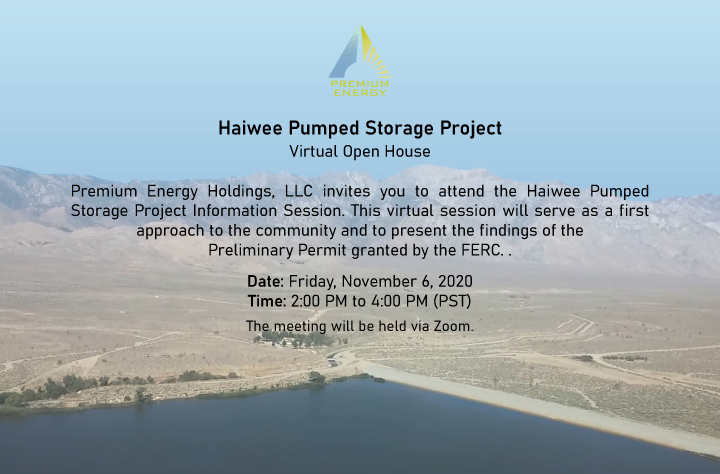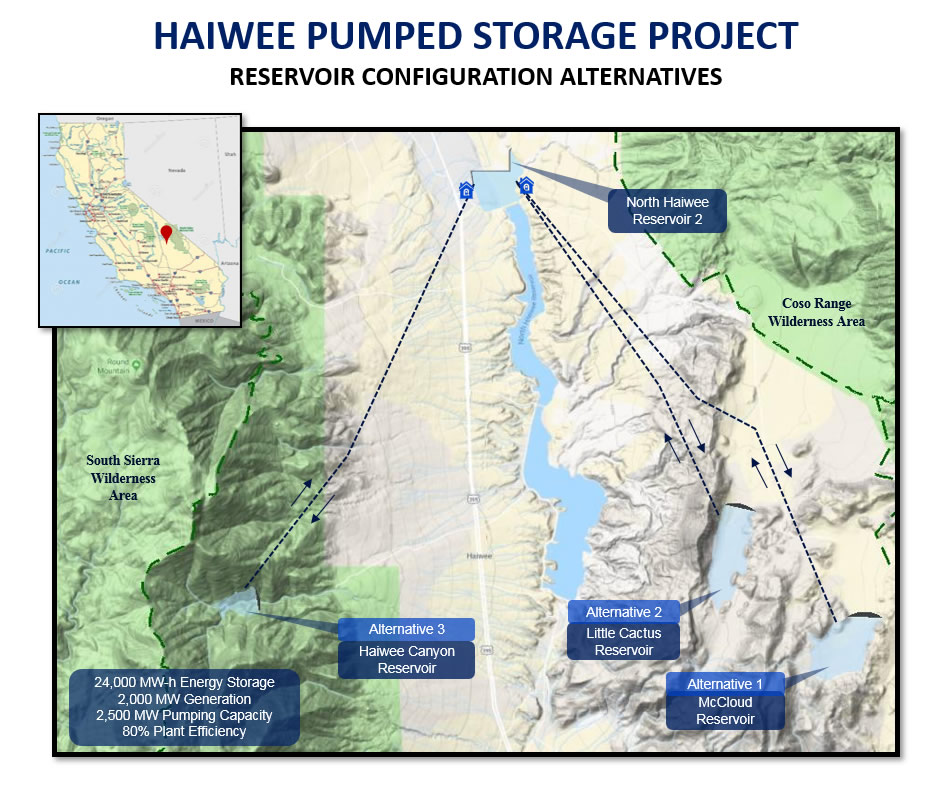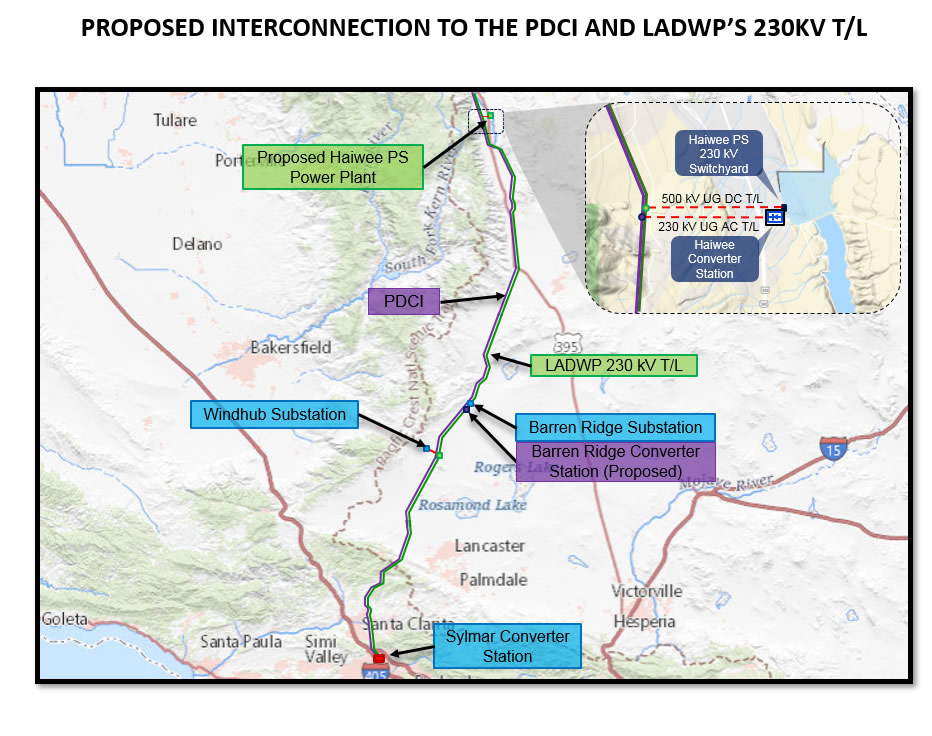HPSP - Haiwee Pumped Storage Project
by Premium Energy Holdings, LLC
Engineering by PowerTech Engineer, Inc. & WAPCOS Ltd.

Background
On March 19, 2020, the FERC issued the preliminary permit to Premium Energy Holdings, LLC (PEH), for a period effective the first day of the month in which this permit is issued (March 1, 2020). The purpose of a preliminary permit is to preserve the right of the permit holder to have the first priority in applying to a license for the Project under the Federal Power Act, allowing Premium Energy Holdings to conduct investigations and secure necessary data to determine the feasibility of the Project and to prepare a license application.
About the Project
The new upper reservoir alternatives are listed below.
- Upper Reservoir Alternative 1: A new McCloud Reservoir at 5,260 ft el.
- Upper Reservoir Alternative 2: A new Little Cactus Reservoir at 4,980 ft el.
- Upper Reservoir Alternative 3: A new Haiwee Canyon Reservoir at 6,160 ft el.
- Earthworks and grading to obtain the proposed reservoir floor.
- Realignment of a section of the existing Cactus Flats Road and the existing North Haiwee Road.
- Realignment of the existing LA Aqueduct reaching the existing North Haiwee Reservoir.
- Construction of a diversion structure and connecting channel or pipeline to the proposed North Haiwee Reservoir 2.
Documents
PEH Licensing Documents
Premium Energy Holdings, LLC will be developing and publishing a variety of documents throughout the licensing process. The following documents are associated with the Integrated Licensing Process (ILP):
FERC Licensing Documents
The Federal Energy Regulatory Commission (FERC) will issue documents related to the Intermountain Pumped Storage Project licensing. The documents will be available when issued.
Staff
- Director: Victor Rojas
- Engineering: PTE Inc. / WAPCOS Ltd.
- Regulatory Representative: Maria Hernandez
- Media Public Affairs Representative: Vicki Rojas
- Land Representative: Bruce Hammer
- Government Affairs Representative: Rod Clark
- Environmental Representative: Bruce Hammer
- Stakeholders Outreach Representative: John Dennis
FAQ
What is Pumped-Storage Hydropower?
Please, check out this video provided by the U.S. Department of Energy, What is Pumped-Storage Hydropower.
Currently, Pumped-Storage accounts for around 95% of all utility-scale energy storage in the U.S. However, as stated by the Energy Information Administration (EIA), most of the PS Generator were built in the 1970s. Also, the ever-increasing energy demand challenges electric utilities and investors to keep pace by developing long-term projects that may help to cover the electric demand. Pumping-Storage, besides provinding energy supply, it also provides reliability to the grid.
Closed-loop pumped storage projects have a lower and upper reservoir, which are not connected to any other body water (such as a river). The same water is repeatedly used in the charging and discharging process.
Open-loop pumped storage projects are connected to a ongoing stream of water, which is used in the charge/discharge process to store and deliver energy. The storage capacity depends on the water available in the natural water feature.
In general, Closed-loop projects have less impact on aquatic resources. These impacts are primarily related to the initial reservoir filling process.
Energy Storage consists on collecting electrical energy when there is an excess of generation, and deliver it to the grid later.
The most common large-scale energy storage is pumped storage, which can be used to replace thermal generation, substitute the need of spinning reserve, or increase reliability and stability of the grid.
It is also used to store energy from intermitent renewable energy sources, such as solar or wind farms.
Pumped-storage facilities can help meeting greenhouse gas emissions reduction targets and build clean renewable energy capacity. In addition, these plants can enhance the reliability and stability of the grid.
Is Pumped-Storage safe?
Any storage solution must comply with safety requirements in order to be sustainable. The main risk related to pumped storage facilities is dam safety. If it occurs, dam failure can affect downstream communities and the environment. Nevertheless, pumped hydro technology is mature, dam risks are generally well understood and managed, and the frequency of dam safety events is very low.
What is the lifespan of a Pumped-Storage project?
Pumped-Storage Hydro is a proven technology and has a typical lifespan well over 50 years, and is the most cost-effective solution for large-scale energy storage, compared to batteries, which currently last between 8 and 15 years.
Premium Energy Holdings, LLC invites you to attend the Haiwee Pumped Storage Project Information Session. This virtual session will provide information.
The meeting session will be held via Zoom, please register at:
Date: Friday, November 6, 2020.
Time: 2:00 PM - 4:00 PM
For further information or if you would like to submit questions, please contact Maria Hernandez at
(909)595-5314 or at maria.hernandez@pehll.com
________________________________________________________________
The webinar is now available to the public on the button below.
Also, the slides presentation.
PremiumEnergyHoldings LLC, appreciates public interest in this project.
Project Insight
Details of the project are publicly presented. If you live nearby the proposed location or you are just interested in what has been presented and have any feedback or questions we would gladly receive it.
Download the presentation HERE.
Contact us at:
info@premiumenergyholdings.com
info@pehllc.com
SUBSCRIBE
STAY UPDATED ABOUT ANY NEWS ON THIS PROJECT BY EMAIL
Receive information on the progress of the project, future meetings, and answers to any question you may have.





